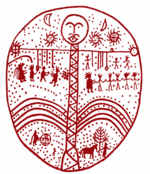Similar topics
Christian Mythology
2 posters
Page 1 of 1
 Christian Mythology
Christian Mythology
All of the info I'm going to presenting in this topic over the next couple of weeks, is from a friend of mine - Peter (Stone Warlock)
The early Christian empire was divided into five major `families', each strategically positioned within the five trade routes. These families had their headquarters at Alexandria, Antioch, Constantinople, Jerusalem and Rome. The families were subdivided into sub-families. Each of the heads of the sub-families, known as Patriarchs (or Bishops), dictated Christian policy best suited to their various regions.
Emperor Constantine, with the enforcement of the Edict of Milan in 313, found himself the subject of Senatorial criticism due to the lack of uniform policy of the Christian families. In 325 he summoned the heads of the families as well as the sub-families to a meeting held at Nicaea on May 20. Of the 1 800 summonses issued only 318 of the bishops actually turned up at the meeting, thus already showing Christian contempt for non-Christian authority. Two major factions within the business were however present. These were the Arians, under the leadership of Arius, and the Homoousians, under the leadership of Alexander. The Arians were inclined to follow the doctrine of the Gnostic Christians (Hasatan) while the Homoousians were Pauline Christians.
The Hasatan (Arian) faction insisted on presenting the facts surrounding the actual Jesus. ALL records, they protested, showed Jesus to be a mortal human (not a God) who had been tried, found guilty and executed by the Romans for insurrection.
The Homoousians, on the other hand, argued that such truthful presentation was "bad for business". They suggested that the Christ be alienated from the Jesus and depicted as `part of God himself'. Outvoted, the Arions ceded the floor. This marked the beginning of the end of any semblance of truth within Christianity.
Emperor Constantine had a problem concerning the trial and execution of Jesus. The decision was made to exonerate the Romans and, in their place, blame the Jews. New `scripture' was commissioned that depicted Jesus being found innocent by Pilot (on totally different charges). The new `scripture' now showed the JEWS as insisting that Jesus be crucified. As no argument could be found for the reason for Jewish insistence, new `prophecies' were written indicating that God, himself, dictated the outcome.
Alexander pointed out that intelligent scholars would still be able to couple the Christ to the real Jesus by examining the date of the execution, which was the Jewish date 14th Nisan. The decision was reached to discard the real date. No actual date for the `new' crucifiction was determined at that meeting.
The meeting adjourned on the afternoon of June 19.
[u]
The first Council of Nicaea
The early Christian empire was divided into five major `families', each strategically positioned within the five trade routes. These families had their headquarters at Alexandria, Antioch, Constantinople, Jerusalem and Rome. The families were subdivided into sub-families. Each of the heads of the sub-families, known as Patriarchs (or Bishops), dictated Christian policy best suited to their various regions.
Emperor Constantine, with the enforcement of the Edict of Milan in 313, found himself the subject of Senatorial criticism due to the lack of uniform policy of the Christian families. In 325 he summoned the heads of the families as well as the sub-families to a meeting held at Nicaea on May 20. Of the 1 800 summonses issued only 318 of the bishops actually turned up at the meeting, thus already showing Christian contempt for non-Christian authority. Two major factions within the business were however present. These were the Arians, under the leadership of Arius, and the Homoousians, under the leadership of Alexander. The Arians were inclined to follow the doctrine of the Gnostic Christians (Hasatan) while the Homoousians were Pauline Christians.
The Hasatan (Arian) faction insisted on presenting the facts surrounding the actual Jesus. ALL records, they protested, showed Jesus to be a mortal human (not a God) who had been tried, found guilty and executed by the Romans for insurrection.
The Homoousians, on the other hand, argued that such truthful presentation was "bad for business". They suggested that the Christ be alienated from the Jesus and depicted as `part of God himself'. Outvoted, the Arions ceded the floor. This marked the beginning of the end of any semblance of truth within Christianity.
Emperor Constantine had a problem concerning the trial and execution of Jesus. The decision was made to exonerate the Romans and, in their place, blame the Jews. New `scripture' was commissioned that depicted Jesus being found innocent by Pilot (on totally different charges). The new `scripture' now showed the JEWS as insisting that Jesus be crucified. As no argument could be found for the reason for Jewish insistence, new `prophecies' were written indicating that God, himself, dictated the outcome.
Alexander pointed out that intelligent scholars would still be able to couple the Christ to the real Jesus by examining the date of the execution, which was the Jewish date 14th Nisan. The decision was reached to discard the real date. No actual date for the `new' crucifiction was determined at that meeting.
The meeting adjourned on the afternoon of June 19.
[u]
Tombe- Age : 35
Location : Cape Town, South Africa
Number of posts : 9
Registration date : 2009-08-14
 Re: Christian Mythology
Re: Christian Mythology
I often find it shocking how little most practicing Christians know about what happened at any of the councils - especially the first at Nicea.
Maybe this thread will help!? ... but I don't know how many Christians will be lurking our forums.
Maybe this thread will help!? ... but I don't know how many Christians will be lurking our forums.

ankh_f_n_khonsu- Number of posts : 545
Registration date : 2008-09-15
Page 1 of 1
Permissions in this forum:
You cannot reply to topics in this forum
